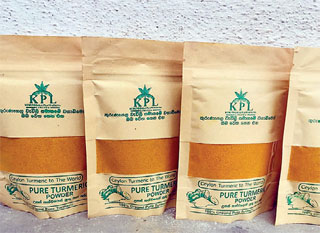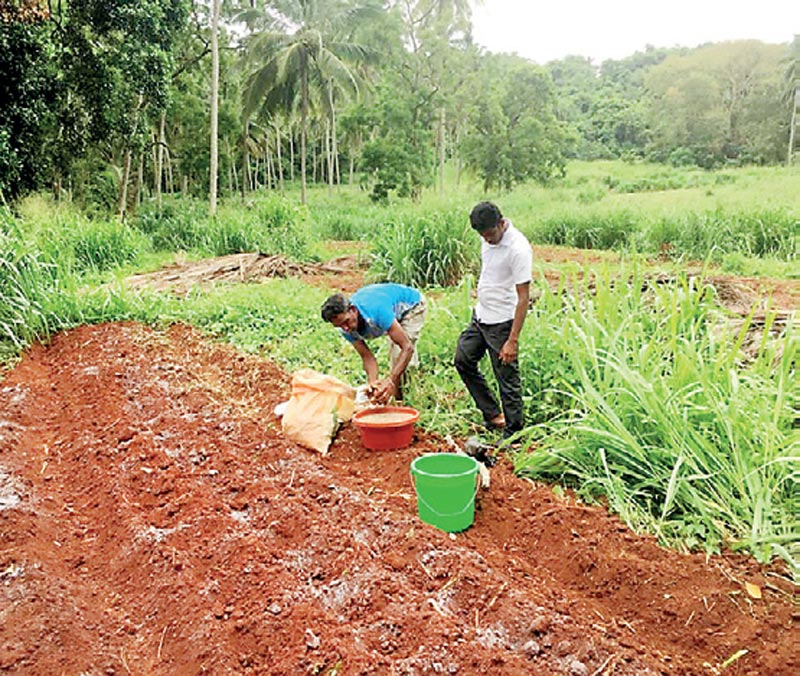Tuesday Jun 03, 2025
Tuesday Jun 03, 2025
Wednesday, 30 March 2022 02:59 - - {{hitsCtrl.values.hits}}

DEA Director, Research Dr. H.M.P.A. Subasinghe

KPL Chief Executive Officer S.M.M. Samarakoon
|
By Randima Attygalle
|
KPL's turmeric processing centre empowering rural communities
|
In 2020, Sri Lanka’s turmeric imports of nearly 815 mt. recorded a value of Rs. 183.16 million, according to the Sri Lanka Customs sources. The largest exporter of turmeric to Sri Lanka until the Government ban on its imports in 2021 was India. Against the import volumes of turmeric in 2020, our exports were insignificant amounting to only 69.3 mt worth of Rs. 86.3 million. The ban on turmeric import has not only led to the country becoming self-sufficient in this essential spice but also showing signs of a promising export market. Wayside turmeric vendors also are an index to the country’s bountiful turmeric harvest.
The estimated production of fresh turmeric for this year is 65,000 mt. according to the figures of the Department of Export Agriculture (DEA). The turmeric requirement for food preparation is 7,500 to 8,000 mt. in dry form and 45,000 to 48,000 in fresh form. For religious, cultural and disinfectant purposes, there is an annual requirement of 3,500 mt.
A growing export market
With Sri Lanka reaching self-sufficiency in turmeric, new processes in the value chain and value addition are now urgent. This surplus, as DEA Director, Research Dr. H.M.P.A. Subasinghe explains, can be utilised either through preservation or value addition. “Turmeric can be preserved as dry fingers, powder or in paste form and value addition too can be done in the form of powder, paste, pills, oil and oleoresin. All these products have a good export market and particularly organic turmeric for which there is a great demand in Japan.” France, Canada, UK, Germany, South Korea, USA and Australia are the other leading buyers of our turmeric.
|
|
Health properties of turmeric are many |
 |
| Turmeric promoted under KPL brand
|
Ideal climatic conditions
Turmeric thrives in sandy loam soil found in the low country intermediate zone (Anuradhapura, Ampara), low country wet zone (Gampaha) and mid country intermediate zone (Matale, Kurunegala, Kandy) as explained by DEA Director-Regulation and Soil Scientist Prasad Idamekorala. The crop covers an area of 1,420 ha. Turmeric intercropping with coconut is largely practiced in Gampaha and Kurunegala districts. “The crop needs an evenly distributed rainfall of 1,750-2,000 mm during its first six months and an optimum temperature range of 24 ºC – 30 ºC.” Soil moisture and solar radiation are the most critical factors for a bumper turmeric harvest, according to Idamekorala.
It takes 9 to 10 months for turmeric seeds to mature and ready to be harvested. “When leaves turn yellow it is an indication that the crop is ready for the harvest. Dry leaves are cut and mature rhizomes are completely unearthed for which manual labour is largely used,” explains the scientist. Turmeric, once harvested should be stored in cool, dry places until processed, which helps to avoid bud initiation; and new turmeric processing methods involving slicing machines and mechanical drying are now in place. Post-harvest losses in turmeric are negligible if farmers can clean and dry the harvest using appropriate techniques, points out Dr. Subasinghe.
Certified price
A turmeric-purchasing program has been implemented in several districts including Gampaha and Ampara and very recently in the Hambantota District with the support of the Department of Agriculture and the Department of Export Agriculture. Farmers are offered a price of Rs. 165 per kilo of turmeric under this scheme during the peak season which is late February and early March.
However, many farmers lament that they still get only about Rs. 130 to 150 per kilo despite the so-called certified price. DEA, however assures that the certified price of Rs. 165 is to be implemented island-wide under its purchasing program. “We have several DEA-run outlets for which we supply spices including turmeric from farmers including smallholders,” notes Dr. Subasinghe. He also adds that ‘off season turmeric’ can fetch about Rs. 600 per kilo. “However, when it reaches the harvesting times, there is a gradual price decrease and again in late March or during April when turmeric seeds are required for sowing, a slight price hike can be expected.”
|
Consumer woes
Although a drop in the retail turmeric price is apparent since the country became self-sufficient, it will take some more time for a notable price decrease per 100 g of turmeric powder. According to the vendors, 100 g of packeted turmeric powder which was sold at around Rs. 600 is now sold at about Rs. 500. The price, however, varies according to the brand. Turmeric in ‘loose form’ (unpacketed) is less in price and the vendors claim that this is due to the inferior quality of it. Consumers charge that most of the unpacketed turmeric found in groceries is adulterated.
Good practices for better harvest
Although a slight yield reduction may be apparent due to the lack of chemical fertiliser, growers can manage with organic fertiliser and local chemical fertiliser such as ERP and Dolomite, observes the agriculturist. “Most important factor is soil moisture and solar radiation and farmers can still get a satisfactory profit margin even with available organic fertiliser recommendations.” Good practices such as selection of healthy seeds, planting at the right time, land preparation with recommended practices, supplementary irrigation with sprinklers, moisture conservation practices and inter-cropping with coconut under shade (around 30%) are recommended by the DEA for a bumper harvest of turmeric.
The DEA has taken several measures to expand local cultivation. These include providing subsidies for seed rhizomes, registering farmers producing seed material, technology transfer through training programs and mass media, new planting programs for expanding the cultivation and subsidies for sprinkler irrigation systems and post-harvest machinery. DEA also assists growers with production of planting material through small rhizome cuttings and tissue culture. Machinery for processing including peeling, drying and powdering and making organic fertiliser recommendations are among services provided.
Health benefits
Sri Lankan turmeric is superior to Indian turmeric in many ways, says Dr. Subasinghe. “Curcumin is the most important chemical component in turmeric and ours has a higher curcumin content. While Indian turmeric contains 2 to 3.5% of curcumin, local turmeric contains 3 to 7%. Sri Lankan turmeric also contains a higher level of flavonoid and oil.” In addition to being a flavouring agent, turmeric also has considerable medicinal properties. Notable for antioxidant and anti-inflammatory abilities, turmeric increases brain functions and lowers the risk of heart disease, cancer and Alzheimer’s disease, ayurvedic physicians say. It also has anti-ageing properties and maintains skin elasticity. Turmeric can also help reduce depression and keep arthritis at bay.
|
|
Ideal intercrop with coconut
|
An ideal intercrop
Encouraged by the performance of the initial five-acre cover of turmeric, Kurunegala Plantations Ltd. (KPL) has expanded its acreage to 20 today. Five acres of KPL estate-lands in Kalawewa, Dodangaslanda, Kurunegala, Narammala, Dambadeniya, Attanagalla and Katugampola were planted with 3,600 kg of seed material. The highest profit per land unit was derived from KPL’s Kalawewa estate.
Turmeric is KPL’s latest commercial inter-crop added to pepper, cinnamon, cocoa, mango, dragon fruit, guava, mangosteen, cashew and rambutan.
“Turmeric is an ideal inter-crop with coconut and mangoes. Out of our 12,250 acres of land, we maintain 9,000 acres of coconut and there is ample space between coconut palms for turmeric,” remarks KPL Chief Executive Officer S.M.M. Samarakoon. “We are slowly expanding our market share under the KPL brand and we recently set up a turmeric processing factory and initiated another joint venture with the DEA to distribute high-quality seed material to the growers,” says Samarakoon who goes on to note that with the assistance of the DEA, they have been able to develop seed turmeric. KPL’s turmeric is also purchased by DEA outlets.
High returns on investment
The harvest ratio of turmeric is 1 in 14, says KPL’s CEO. “We fetch about Rs. 165 per kilo of raw turmeric and about Rs. 4,220 per kilo of processed turmeric. The return on investment is very high and with proper irrigation facilities in place, farmers can plant it around the year without being confined to Yala and Maha seasons. However, with this inflation, the cost of production is bound to increase,” notes the senior planter. Although a rich harvest can be achieved with organic fertiliser, scarcity of quality organic fertiliser is a significant challenge for cultivators, observes the senior planter.

Turmeric seeds being planted
|
|
Preparing the ground for sowing
|
Retaining interest in the crop
Maintaining a stable certified price for turmeric is crucial, observes Samarakoon, who warns that if the prices come down, cultivators could be discouraged which will threaten our self-sufficiency. Many plans are envisaged by KPL to retain the interest of the smallholders in the crop and to tap a bigger export market. “We need to tap the technology for a better outcome, especially to extract curcumin which has a high demand in the international market for its medical properties.” KPL’s CEO also goes on to note that turmeric is also an ideal smallholder crop which can help alleviate poverty. “Besides enabling employment opportunities at our processing factory, we also assist such smallholders by purchasing turmeric from them.”
Discover Kapruka, the leading online shopping platform in Sri Lanka, where you can conveniently send Gifts and Flowers to your loved ones for any event including Valentine ’s Day. Explore a wide range of popular Shopping Categories on Kapruka, including Toys, Groceries, Electronics, Birthday Cakes, Fruits, Chocolates, Flower Bouquets, Clothing, Watches, Lingerie, Gift Sets and Jewellery. Also if you’re interested in selling with Kapruka, Partner Central by Kapruka is the best solution to start with. Moreover, through Kapruka Global Shop, you can also enjoy the convenience of purchasing products from renowned platforms like Amazon and eBay and have them delivered to Sri Lanka.
Discover Kapruka, the leading online shopping platform in Sri Lanka, where you can conveniently send Gifts and Flowers to your loved ones for any event including Valentine ’s Day. Explore a wide range of popular Shopping Categories on Kapruka, including Toys, Groceries, Electronics, Birthday Cakes, Fruits, Chocolates, Flower Bouquets, Clothing, Watches, Lingerie, Gift Sets and Jewellery. Also if you’re interested in selling with Kapruka, Partner Central by Kapruka is the best solution to start with. Moreover, through Kapruka Global Shop, you can also enjoy the convenience of purchasing products from renowned platforms like Amazon and eBay and have them delivered to Sri Lanka.